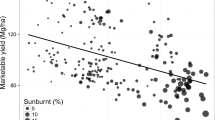Abstract
The effects of organic (composted cow manure) and synthetic (NPK) fertilizers on pests (aphids and flea beetles) and predatory arthropods (anthocorids, coccinellids and chrysopids) associated with tomatoes were evaluated in a 2-year randomized complete block field experiment. Our data suggested that the application of either organic or synthetic fertilizers could increase pest populations on tomatoes. However, there were lower populations of aphids on tomatoes grown with the organic fertilizer than on those grown with the synthetic fertilizers in the second year of the experiment, indicating that organic fertilizers may have the potential to reduce pest attacks in the long term. Anthocorid populations were larger on tomato plants with high aphid populations in the synthetic than in the organic fertilizers-treated plots.
Similar content being viewed by others
References
Archer, T.L., Bynum, E.D. Jr., Onken, A.B. and Wendt, C.W. (1995) Influence of water and nitrogen fertilizer on biology of the Russian wheat aphid (Homoptera: Aphididae) on wheat.Crop Prot. 14:165–169.
Barbour, J.D., Farrar, R.R. and Kennedy, G.G. (1991) Interaction of fertilizer regime with host-plant resistance in tomato.Entomol. Exp. Appl. 60:289–300.
Bentz, J.-A., Reeves, J. III, Barbosa, P. and Francis, B. (1995) Nitrogen fertilizer effect on selection, acceptance, and suitability ofEuphorbia pulcherrima (Euphorbiaceae) as a host plant toBemisia tabaci (Homoptera: Aleyrodidae).Environ. Entomol. 24:40–45.
Bethke, J.A., Redak, R.A. and Schuch, U.K. (1998) Melon aphid performance on chrysanthemum as mediated by cultivar, and differential levels of fertilization and irrigation.Entomol. Exp. Appl. 88:41–47.
Culliney, T.W. and Pimentel, D. (1986) Ecological effects of organic agricultural practices on insect populations.Agric. Ecosyst. Environ. 15:253–256.
Edwards, C.A. and Stinner, B.R. (1990) The use of innovative agricultural practices in a farm systems context for pest control in the 1990s.Brighton Crop Protection Conf. — Pests and Diseases vol. 7C-3, pp. 679–684.
Eigenbrode, S.D. and Pimentel, D. (1988) Effects of manure and chemical fertilizers on insect pest populations on collards.Agric. Ecosyst. Environ. 20:109–125.
Fragoyiannis, D.A., McKinlay, R.G. and D’Mello, J.P.F. (2001) Interactions of aphid herbivory and nitrogen availability on the total foliar glycoalkaloid content of potato plants.J. Chem. Ecol. 27:1749–1762.
Hasken, K.-H. and Poehling, H.-M. (1995) Effects of different intensities of fertilisers and pesticides on aphids and aphid predators in winter wheat.Agric. Ecosyst. Environ. 52:45–50.
Herms, D.A. (2002) Effects of fertilization on insect resistance of woody ornamental plants: Reassessing an entrenched paradigm.Environ. Entomol. 31:923–933.
Hunt, D.W.A., Drudy, C.G. and Maw, H.E.L. (1992) Influence of nitrogen on the performance of Colorado potato beetle (Coleoptera: Chrysomelidae) on tomato.Environ. Entomol. 21:817–821.
Jansson, R.K. and Smilowitz, Z. (1986) Influence of nitrogen on population parameters of potato insects: Abundance, population growth and within-plant distribution of the green peach aphid,Myzus persicae (Homoptera: Aphididae).Environ. Entomol. 15:49–55.
Kalule, T. and Wright, D.J. (2002) Tritrophic interactions between cabbage cultivars with different resistance and fertilizer levels, cruciferous aphids and parasitoids under field conditions.Bull. Entomol. Res. 92:61–69.
Kasyap, R.K. and Batra, B.R. (1987) Influence of some crop management practices on the incidence ofHeliothis armigera (Hübner) and yield of tomato (Lycopersicon esculentum Mill.) in India.Trop. Pest Manage. 33:166–169.
Letourneau, D.K., Drinkwater, L. and Shennan, C. (1996) Effects of soil management on crop nitrogen and insect damage in organic vs. conventional tomato fields.Agric. Ecosyst. Environ. 57:179–187.
Morales, H., Perfecto, I. and Ferguson, B. (2001) Traditional fertilization and its effect on corn insect populations in the Guatemalan highlands.Agric. Ecosyst. Environ. 84:145–155.
Patriquin, D.G., Baines, D. and Abboud, A. (1995) Diseases, pests and soil fertility.in: Cook, H.F. and Lee, H.C. [Eds.] Soil Management in Sustainable Agriculture. Wye College Press, Wye, UK. pp. 161–174.
Patriquin, D.G., Baines, D., Lewis, J. and MacDougall, A. (1988) Aphid infestations of fababeans on an organic farm in relation to weeds, intercrops and added nitrogen.Agric. Ecosyst. Environ. 20:279–288.
Phelan, P.L., Mason, J.F. and Stinner, B.R. (1995) Soil-fertility management and host preference by European corn borer,Ostrinia nubilalis (Hübner), onZea mays L.: A comparison of organic and conventional chemical farming.Agric. Ecosyst. Environ. 56:1–8.
Rao, K.R. (2002) Induced host plant resistance in the management of sucking insect pests of groundnut.Ann. Plant Prot. Sci. 10:45–50.
Shaw, M.C., Wilson, M.C. and Rhykerd, C.L. (1986) Influence of phosphorus and potassium fertilization on damage to alfalfa,Medicago sativa L., by the alfalfa weevil,Hypera postica (Gyllenhal) and potato leafhopper,Empoasca fabae (Harris).Crop Prot. 5:245–249.
Sudhakar, K., Punnaiah, K.C. and Krishnayya, P.V. (1998) Influence of organic and inorganic fertilizers and certain insecticides on the incidence of shoot and fruit borer,Leucinodes orbonalis Guen. infesting brinjal.J. Entomol. Res. 22:283–286.
White, T.C.R. (1984) The abundance of invertebrate herbivores in relation to the availability of nitrogen in stressed food plants.Oecologia 63:90–105.
Author information
Authors and Affiliations
Corresponding author
Additional information
http://www.phytoparasitica.org posting July 6, 2003.
Rights and permissions
About this article
Cite this article
Yardım, E.N., Edwards, C.A. Effects of organic and synthetic fertilizer sources on pest and predatory insects associated with tomatoes. Phytoparasitica 31, 324–329 (2003). https://doi.org/10.1007/BF02979802
Received:
Revised:
Issue Date:
DOI: https://doi.org/10.1007/BF02979802




